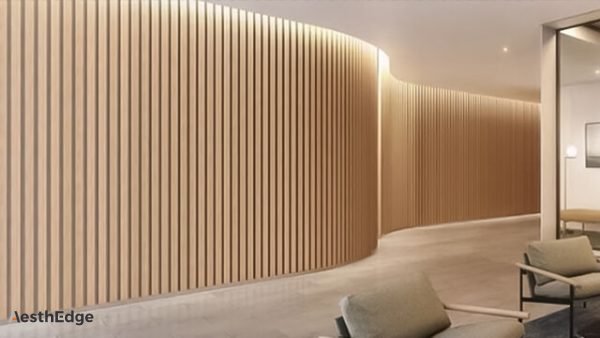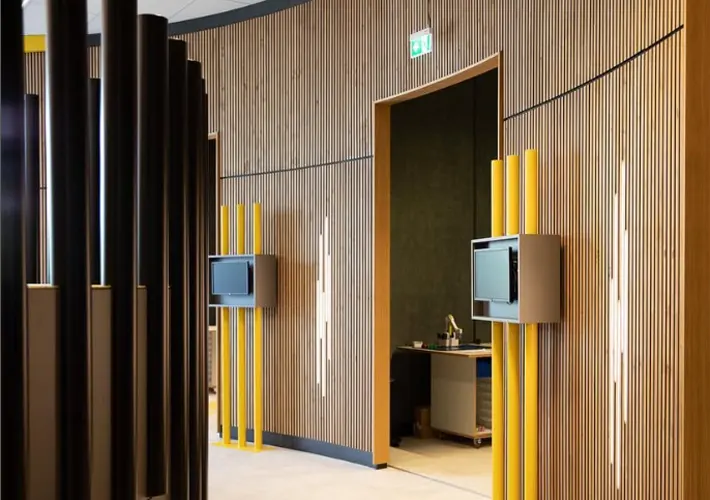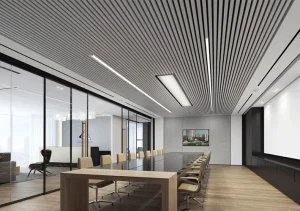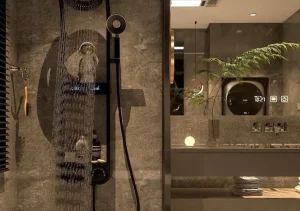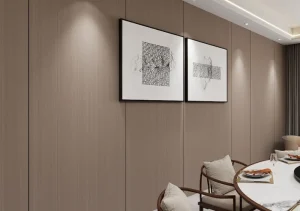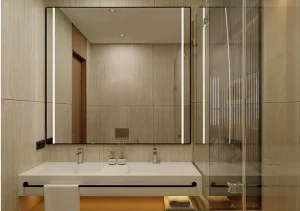In today’s fiercely competitive hotel industry, the guest experience is no longer limited to comfortable bedding or attentive service. However, modern travelers pursue a comprehensive sensory satisfaction, an environment design that blends luxury, comfort, and functionality. However, acoustic design, as the most essential factor often overlooked, is gradually becoming the core of hotel differentiation competition. Whether it’s the noise in the lobby, echoes in the hallway, or poorly insulated rooms, noise issues can directly affect guests’ check-in experience and even damage the hotel’s reputation.
As a new comprehensive solution, acoustic panels cleverly combine sound insulation technology with decorative aesthetics, bringing revolutionary changes to hotel spaces. This article will delve into the application value of acoustic wall panels in hotel decoration, covering their core advantages, design possibilities, installation strategies, and practical cases, providing the most practical guide for hotel operators, designers, and architecture enthusiasts.

Table of Contents
ToggleWhy acoustic design has become a new battlefield for hotel competitiveness
1.1 Noise Issue: The Hidden Killer of Hotel Negative Reviews
According to the survey, noise complaints are one of the most common issues in hotel negative reviews. The noise of cars on the road, conversations in adjacent rooms, and the buzzing sound of air conditioning systems not only affect sleep quality, but also reduce guests’ trust in privacy. In high-end hotels, customers paying high prices in search of quiet and comfortable expectations may be shattered, which could lead to a decrease in brand loyalty or even direct economic losses.
1.2Upgrading thinking from “sound insulation” to “soundscape design”
Leading hotel brands are no longer satisfied with traditional sound insulation methods, but have elevated acoustic design to a new level of spatial experience strategy, that is, by scientifically planning the sound field environment and creating immersive scenes with “dynamic and static zones”:
Dynamic area: such as bars and restaurants, retain the humidity environment sound to create a vibrant atmosphere.
Static areas, such as guest rooms and conference rooms, require absolute quietness to ensure focus and relaxation.
Acoustic wall panels are the core tool for achieving this goal. They are not only “sound insulation materials”, but also design elements that shape the mood of the space.
Acoustic Wall Panel: Dual Evolution of Function and Aesthetics
2.1What is acoustic wall panel?
Acoustic wall panels are materials that absorb, scatter, or block sound waves through special structures such as porous surfaces and internal damping layers. Compared with traditional sound insulation methods such as thick sound insulation cotton, modern acoustic wall panels have the following breakthroughs:
Lightweight: The thickness can be controlled between 2-10 centimeters, saving space.
Decorative: The surface can be customized with wood grain, fabric, and even 3D three-dimensional shapes.
Environmental friendliness: using sustainable materials such as PET fiber and natural wool.
2.2 The four core advantages of acoustic wall panels
Excellent noise reduction performance
The sound absorption coefficient (NRC) can reach 0.8-1.0 (the higher the value, the stronger the sound absorption effect).
The sound insulation level (STC) can reach up to 50 decibels, effectively blocking human voices and low-frequency noise.
Extremely high degree of design freedom
Material selection: perforated wooden board, imitation stone texture, etc.
Color and Pattern: Supports color card customization and can print corporate logos or artistic patterns.
Stereoscopic modeling: wave shaped, geometric splicing, hollow carving, etc., creating a visual focal wall.
Easy installation and maintenance
Modular design, supporting direct pasting, keel suspension, or magnetic installation.
Anti fouling and moisture-proof treatment, suitable for high flow areas in hotels.
Long term cost-effectiveness
Reduce customer complaint handling costs caused by noise complaints.
Extend the service life of the space and avoid the wear and tear of traditional soft packaging materials.

Practical application of acoustic wall panels in hotel spaces
3.1Lobby and Reception Area: The Silent Aesthetics of First Impression
Pain point analysis
Although the design of the open lobby appears grand, the spacious hard walls, glass curtain walls, and marble floors can easily cause sound wave reflections, leading to echo problems. When guests check in, the noise of queuing conversations, rolling luggage wheels, and background music mix together, creating a noisy “sound field conflict” that directly affects the experience and perception of first-time guests.
Deepening the solution
Fabric acoustic panel: Choose high-density polyester fiber or wool blend fabric, with an NRC value of 0.9 or above, which can efficiently absorb mid to high frequency noise (such as human voice and electronic device beeps).
Psychology of Warm Tone Design: Acoustic panels in beige, light gray, or earthy tones can reduce visual pressure and create a balance of warmth and coolness with hard materials such as stone and metal, creating a sense of luxury in tranquility.
Smart partition for spatial zoning
Sound transmitting mesh+wooden frame acoustic partition: Adopting a double-layer structure – the outer layer is a metal mesh with a sound transmission rate of over 90%, embedded with acoustic cotton core material, which not only achieves sound attenuation but also maintains visual transparency.
Modular green plant acoustic wall: Combining acoustic panels with vertical greening, such as embedding ferns in honeycomb aluminum panels, it has the functions of noise reduction, air purification, and decoration.
3.2Rooms and suites: guardians of sleep quality
Pain point disassembly
The three main sources of room noise:
Airborne sound: Traffic outside the window and conversations in the hallway are transmitted through the gaps between doors and windows.
Structural sound transmission: Footsteps from upstairs and elevator vibrations are transmitted through the walls.
Equipment noise: Low frequency buzzing of air conditioning fans and mini bar refrigerators.
Systematic solution
Composite bedside acoustic wall
| level | material | function |
| surface | Flame retardant wool blend fabric | Soft touch, acoustic at medium to high frequencies |
| second floor | 10mm polyester fiberboard | Enhance sound energy dissipation |
| Third layer | 2mm soundproof felt | Block low-frequency sound waves |
| Fourth layer | 50mm rock wool | Filling cavities and shock absorption |
| grass-roots unit | Calcium Silicate Board | Fireproof and moisture-proof substrate |
Acoustic sealing at details
Soundproof skirting board: using EPDM rubber sealing strip and cavity filling foaming agent to block the “sound bridge effect”.
Door and window upgrade plan:
Install magnetic sealing strips on the door frame to increase the sound insulation by 8-10dB.
Double layered laminated glass (6mm+1.52PVB+6mm), with a traffic noise isolation efficiency of 40dB.

3.3Conference and banquet halls: acoustic guarantee for clear communication
Core pain points
Lack of language clarity: In large venues, the audience in the back row often cannot hear the speech clearly due to echo interference.
Multi functional scene conflict: The same space needs to accommodate various modes such as meetings, performances, and banquets, with significant differences in acoustic requirements.
Acoustic principles of diamond shaped acoustic panels on walls
Helmholtz resonator effect: Diamond shaped grooves form multiple small cavities, and when the frequency of sound waves is consistent with the natural frequency of the cavities, a large amount of sound energy is consumed. Improve absorption rate by 40% for low-frequency noise (such as microphone whistling) between 250-500Hz.
Diffusion calculation: Design the concave convex depth based on the Maximum Sequence Length (MLS) algorithm to effectively scatter sound waves above 500Hz.
Design Trend: How Acoustic Wall Panels Become Spatial Artworks
1.The naturalistic trend
Ecological materials: bamboo and wood fiberboard, cork wall panels, paired with green plant patterns, in line with the concept of a “healing hotel”.
Biomimetic modeling: 3D reliefs of honeycomb shapes and leaf veins, combining functionality, practicality, and visual impact aesthetics.
2.Cultural IP implantation
Regional characteristics: Traditional Chinese cultural concepts such as the texture of Dunhuang murals and the window patterns of Suzhou gardens are integrated into it. Presented on acoustic panels through laser engraving.
Brand narrative: Transform the hotel’s historical story into abstract patterns to enhance the hotel’s brand recognition.
3.Technology interactive experience
LED integration: The acoustic wall panel is embedded with programmable light strips, which change colors with the rhythm of music.
Touch interaction: Printed with conductive ink, touch the wall to control intelligent systems such as lighting.
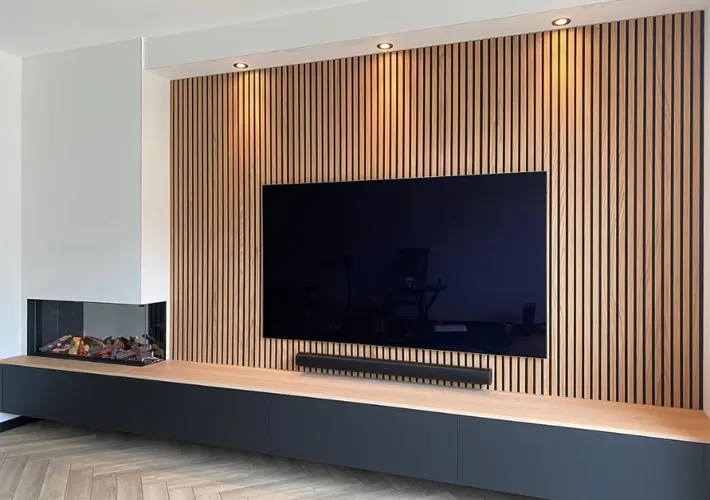
The Golden Rule of Installation and Material Selection
5.1 Scientific Selection: Material Guidelines for Different Spaces
The selection of acoustic wall panels often follows the principle of “prioritizing spatial functions and customizing acoustic performance”. The following are strategies for selecting refined acoustic panels for different regions, combined with acoustic requirements and decorative characteristics for spatial decoration.
| Space Type | Recommended materials | Thickness suggestion | Core design logic |
| Soundproofing wall in guest rooms | Composite soundproof felt+gypsum board | ≥8cm | Mainly to block structural sound transmission: soundproof felt (surface density ≥ 2kg/m ²) blocks low-frequency vibration, gypsum board enhances wall rigidity, and gaps are filled with butyl rubber for sealing. |
| Lobby decorative wall | Perforated wood grain acoustic wall panel | 2-5cm | Balancing sound absorption and aesthetics: Birch/walnut veneer with a perforation rate of 15% -25%, sound-absorbing cotton backing, balancing NRC 0.7 with high-end visual texture |
| Restaurant ceiling | Polyester fiber acoustic wall panel | 5-10cm | Efficient absorption of mid to high frequencies: Polyester fiber board with a density of 40-80kg/m ³, cut into irregular modules (such as blades and waves) to reduce the reflection of tableware collision sound. |
| Conference Room | Fabric soft bag+sound-absorbing sponge | 3-6cm | Precise control of reverberation time: 50kg/m ³ melamine sponge wrapped in flame-retardant wool fabric, optimized for the 500-2000Hz vocal frequency band, with a 30% increase in STI value. |
5.2 Avoiding pitfalls guide: common misconceptions and solutions
Misconception : “Sound absorption=complete sound insulation”
Root cause of mistaken cognition: Confusing the physical principles of “sound absorption” (absorbing indoor reflected sound) and “sound insulation” (blocking external incoming sound).
Technical analysis and solutions:
If external noise needs to be addressed (such as street facing guest rooms): adopt the “quality law” sound insulation structure, such as “gypsum board+sound insulation felt+shock-absorbing keel+gypsum board” sandwich wall, STC value must be ≥ 50.
If you need to solve indoor echoes (such as banquet halls): prioritize increasing the NRC value and installing porous sound-absorbing materials.

Future prospects: Intelligent and sustainable acoustic revolution
Responsive sound absorption system:
Built in sensors monitor noise frequency in real-time and automatically adjust the porosity of the wall panel (tighten the structure in case of low-frequency noise).
Innovation in environmentally friendly materials:
Mycelium acoustic wall panel: Utilizing fungal biosynthesis technology, it is 100% biodegradable.
Marine Plastic Recycling Board: Recycling polyester fibers from fishing nets to help achieve carbon neutrality goals. Assist in the sustainable development strategy.
Virtual Acoustic Simulation:
Preview the design plan through VR technology, accurately calculate the sound field distribution, and avoid rework costs.
Conclusion
Acoustic panels have evolved from the most concealed engineering materials to strategic decorative elements in hotel design through the evolution and research of industry materials. It is not only a tool for solving noise problems, but also a carrier for enhancing brand value and shaping spatial memory points. Under the current dominance of the experience economy, investing in acoustic design means investing in the emotional resonance of guests. When every room becomes a “safe haven for sound,” hotels truly win future competitiveness.
We are a production factory located in Linyi, Shandong, with decades of experience in production, manufacturing, and sales. If you are interested in this product, you can contact us to obtain product samples.

